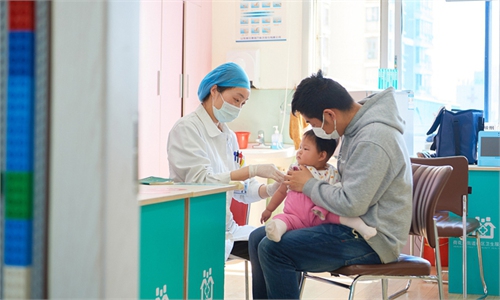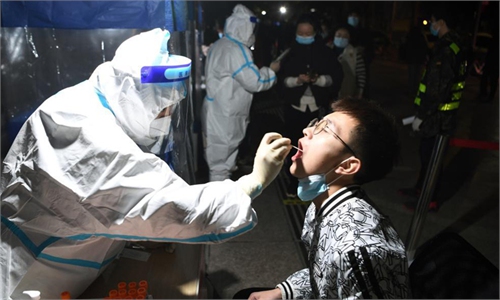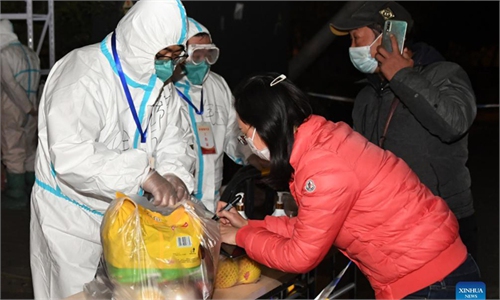Overall COVID-19 situation in China is rapidly developing with proportion of severe cases higher than that of any previous outbreaks: health authority
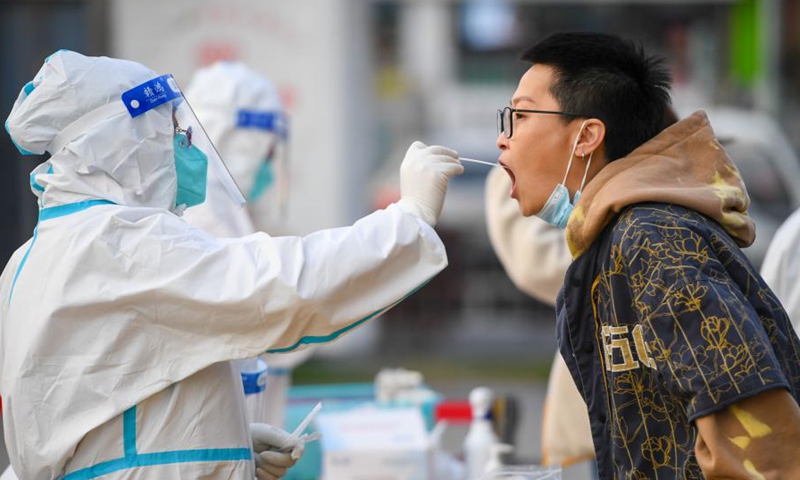
A medical worker takes a swab sample from a resident for nucleic acid testing in Hohhot, north China's Inner Mongolia Autonomous Region, on Oct. 29, 2021.Photo:Xinhua
China's top health authorities said the COVID-19 epidemics in at least ten regions have been or are being brought under control but that the overall state of epidemic in the country is in a fast-developing phase and remains complicated and the proportion of severe cases in this round of epidemic resurgence is higher than that of any previous wave .
In the past 14 days, 14 provinces in China have reported domestically transmitted COVID-19 cases. The current epidemic is still in a rapidly-developing phase and remains complicated, Mi Feng, spokesperson from China's National Health Commission said at a press conference on Saturday afternoon.
The risk of epidemic spread and spillover in China-Mongolia border city Ejin Banner, North China's Inner Mongolia have been effectively controlled as the region had reported no further cases had spilled-over cases to other regions for four days since October 25. Most new cases detected in recent days were identified at quarantined points. Previous anti-epidemic measures have proved to be effective and that viral transmission in communities have been basically controlled.

A medical worker takes a swab sample from a child for nucleic acid test at a residential area in Ejina Banner of Alxa League, north China's Inner Mongolia Autonomous Region, Oct. 20, 2021.Photo: Xinhua
While the outbreak in the China-Russia border city of Heihe in northeast China's Heilongjiang Province is an isolated viral chain that was caused by an imported case, unrelated to those from Inner Mongolia or Gansu.
Since October 27, the outbreak in Heihe rapidly escalated with new cases continued to be detected among mass testing, suggesting that viral spread has caused community transmission and poses risk of further spread or spill over, according to the NHC.
Heihe reported 26 new cases on Friday. As part of anti-epidemic measures, Heihe has switched the health code of all residents in Heihe city to yellow. The traffic-light health code system is an important pass to travel around in the county.
Guo Yanhong, an official from the NHC said about 40 percent of patients discovered in this round of outbreak were elder aged 60 years old and above, a lot higher than previous infection percentage in earlier epidemics, which is said to be around 18.5 percent.
Many of the senior citizens infected have underlying diseases so the proportion of severe cases in this round of epidemic resurgence is higher than that of previous waves, Guo noted.
The five regions - Hubei, Hunan, Sichuan, Guizhou, Shaanxi provinces - have had reported zero new cases for more than four consecutive days, and outbreaks in these areas are being effectively controlled, while the spread of the virus in another five regions - Beijing, Hebei, Shandong, Qinghai, Ningxia - is basically stable, Wu Liangyou, an official from the NHC said at the press conference.
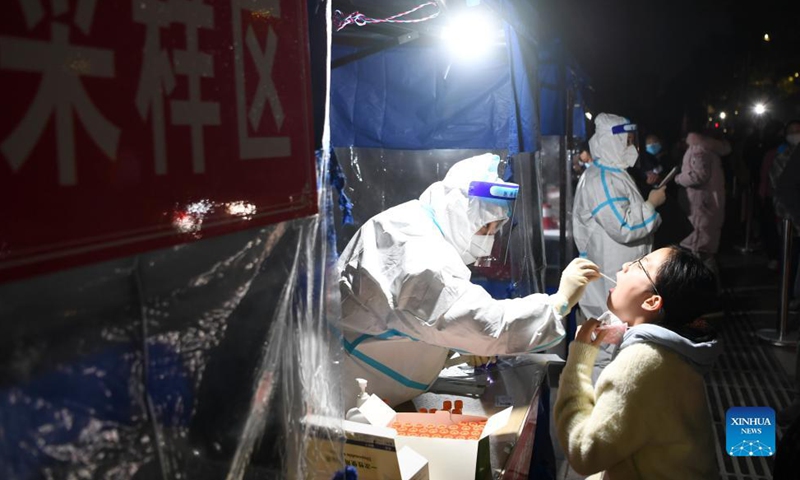
Medical workers collect swab samples at a nucleic acid testing site in Chengguan District of Lanzhou City, northwest China's Gansu Province, Oct. 21, 2021.Photo:Xinhua
In Gansu Province, Wu said most new cases were found among quarantined individuals and some sporadic cases were screened in local communities. Gansu Province will work on speeding up the investigation of the source of infection and cut off the chain of community transmission to mitigate more infection.
This round of COVID-19 outbreak has exposed weaknesses in some places, such as insufficient emergency preparedness and inadequate responsibilities for epidemic prevention and control, Wu noted.
Wu said as the weather turns cold and the epidemic in neighboring countries intensifies, China, especially in port areas, must strictly implement regular epidemic prevention and control measures and strengthen screening and closed-loop management of high-risk populations.
North China's Inner Mongolia has sacked at least four officials due to a poor response to latest COVID-19 flare-up with Sun Jianjun, the Party chief for culture, tourism and television department of the Alxa League, being the most recent personnel change.
While domestic outbreaks have escalated at a rapid pace, vaccination rates have also accelerated. As of Friday, China has administered more than 2.26 billion doses of coronavirus vaccines, and the number of people who have completed full course of vaccination has exceeded 1.07 billion.
Officials recommended those who completed their full-course of vaccination over six months ago to register for a booster shot. The vaccination targeted age group now expands to above three years old from previous 12 years old.
As the vaccine rollout continues, China will encourage children aged three to 11 years old to get vaccinated. As of Friday, the total does for vaccinations for young people aged three to 11 surpassed 3.53 million doses.
Global Times
